cooling JEEP WRANGLER 2010 Owners Manual
[x] Cancel search | Manufacturer: JEEP, Model Year: 2010, Model line: WRANGLER, Model: JEEP WRANGLER 2010Pages: 554, PDF Size: 10.16 MB
Page 435 of 554

The automatic transmission fluid and filter should be
changed if you REGULARLY tow a trailer for more than
45 minutes of continuous operation. Refer to “Mainte-
nance Schedule” for the proper maintenance intervals.
NOTE:Check the automatic transmission fluid level
before towing.
O/D Off
To reduce the potential for automatic transmission over-
heating, select the “O/D OFF” feature when driving in
hilly areas or shift the transmission to DRIVE position 2
on more severe grades. Refer to “Automatic Transmis-
sion” in “Starting and Operating” for further
information.
Electronic Speed Control – If Equipped
�
Do not use in hilly terrain or with heavy loads.
�When using the speed control, if you experience speed
drops greater than 10 mph (16 km/h), disengage until
you can get back to cruising speed.
�Use speed control in flat terrain and with light loads to
maximize fuel efficiency.
Cooling System
To reduce potential for engine and transmission over-
heating, take the following actions:
�Highway Driving
Reduce speed.
�Air Conditioning
Turn off temporarily.
434 STARTING AND OPERATING
Page 442 of 554

NOTE:There are steps that you can take to slow down
an impending overheat condition:
•If your air conditioner (A/C) is on, turn it off. The A/C
system adds heat to the engine cooling system and
turning the A/C off can help remove this heat.
•You can also turn the temperature control to maximum
heat, the mode control to floor and the blower control
to high. This allows the heater core to act as a
supplement to the radiator and aids in removing heat
from the engine cooling system.
Page 449 of 554
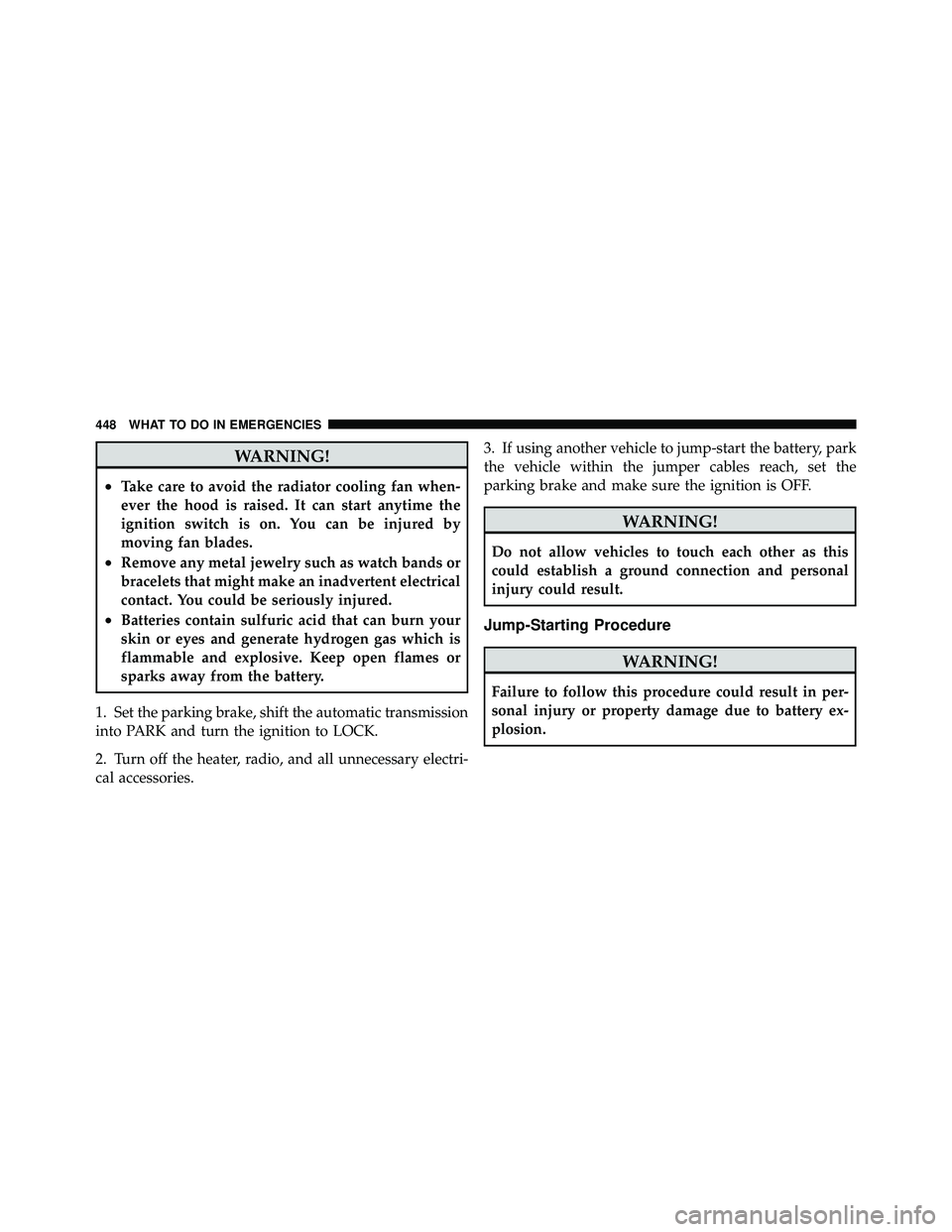
WARNING!
•Take care to avoid the radiator cooling fan when-
ever the hood is raised. It can start anytime the
ignition switch is on. You can be injured by
moving fan blades.
•Remove any metal jewelry such as watch bands or
bracelets that might make an inadvertent electrical
contact. You could be seriously injured.
•Batteries contain sulfuric acid that can burn your
skin or eyes and generate hydrogen gas which is
flammable and explosive. Keep open flames or
sparks away from the battery.
1. Set the parking brake, shift the automatic transmission
into PARK and turn the ignition to LOCK.
2. Turn off the heater, radio, and all unnecessary electri-
cal accessories. 3. If using another vehicle to jump-start the battery, park
the vehicle within the jumper cables reach, set the
parking brake and make sure the ignition is OFF.
Page 471 of 554
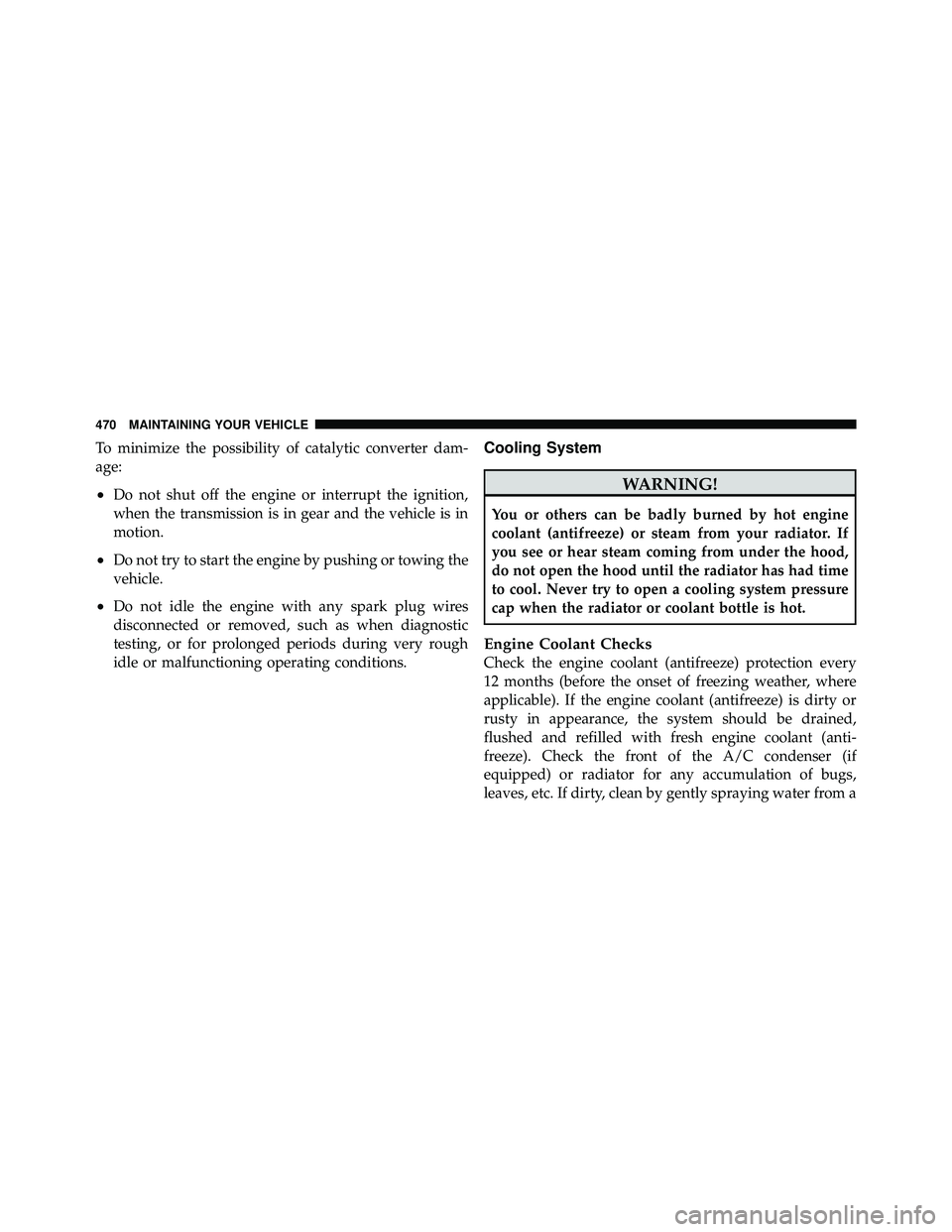
To minimize the possibility of catalytic converter dam-
age:
•Do not shut off the engine or interrupt the ignition,
when the transmission is in gear and the vehicle is in
motion.
•Do not try to start the engine by pushing or towing the
vehicle.
•Do not idle the engine with any spark plug wires
disconnected or removed, such as when diagnostic
testing, or for prolonged periods during very rough
idle or malfunctioning operating conditions.
Cooling System
Page 473 of 554

CAUTION!
•Mixing of engine coolant (antifreeze) other than
the specified HOAT engine coolant (antifreeze)
may result in engine damage and may decrease
corrosion protection. If a non-HOAT engine cool-
ant (antifreeze) is introduced into the cooling
system in an emergency, it should be replaced with
the specified engine coolant (antifreeze) as soon as
possible.
•Do not use water alone or alcohol-based engine
coolant (antifreeze) products. Do not use addi-
tional rust inhibitors or antirust products, as they
may not be compatible with the antifreeze/engine
coolant (antifreeze) and may plug the radiator.(Continued)
Page 475 of 554
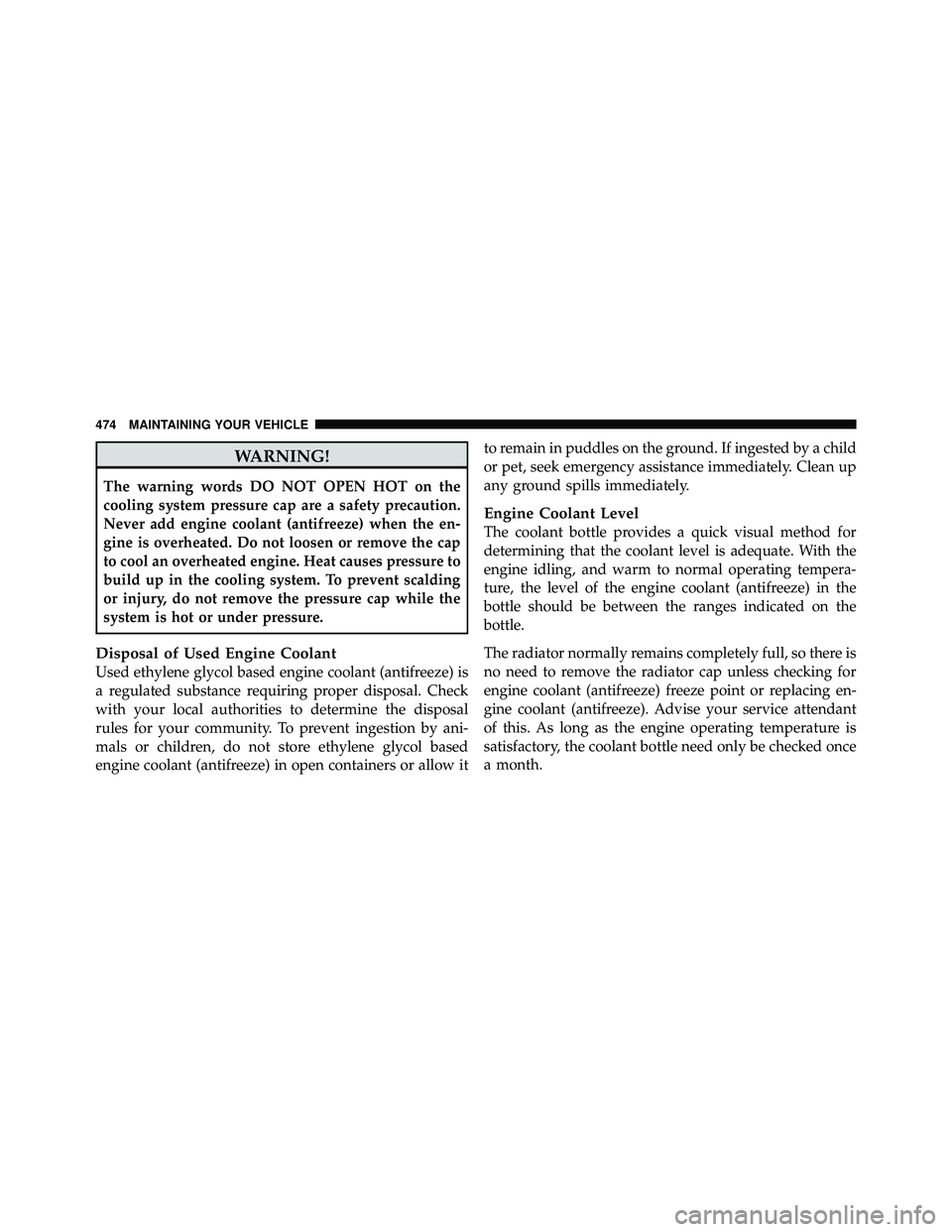
WARNING!
The warning words DO NOT OPEN HOT on the
cooling system pressure cap are a safety precaution.
Never add engine coolant (antifreeze) when the en-
gine is overheated. Do not loosen or remove the cap
to cool an overheated engine. Heat causes pressure to
build up in the cooling system. To prevent scalding
or injury, do not remove the pressure cap while the
system is hot or under pressure.
Disposal of Used Engine Coolant
Used ethylene glycol based engine coolant (antifreeze) is
a regulated substance requiring proper disposal. Check
with your local authorities to determine the disposal
rules for your community. To prevent ingestion by ani-
mals or children, do not store ethylene glycol based
engine coolant (antifreeze) in open containers or allow itto remain in puddles on the ground. If ingested by a child
or pet, seek emergency assistance immediately. Clean up
any ground spills immediately.
Engine Coolant Level
The coolant bottle provides a quick visual method for
determining that the coolant level is adequate. With the
engine idling, and warm to normal operating tempera-
ture, the level of the engine coolant (antifreeze) in the
bottle should be between the ranges indicated on the
bottle.
The radiator normally remains completely full, so there is
no need to remove the radiator cap unless checking for
engine coolant (antifreeze) freeze point or replacing en-
gine coolant (antifreeze). Advise your service attendant
of this. As long as the engine operating temperature is
satisfactory, the coolant bottle need only be checked once
a month.
474 MAINTAINING YOUR VEHICLE
Page 477 of 554
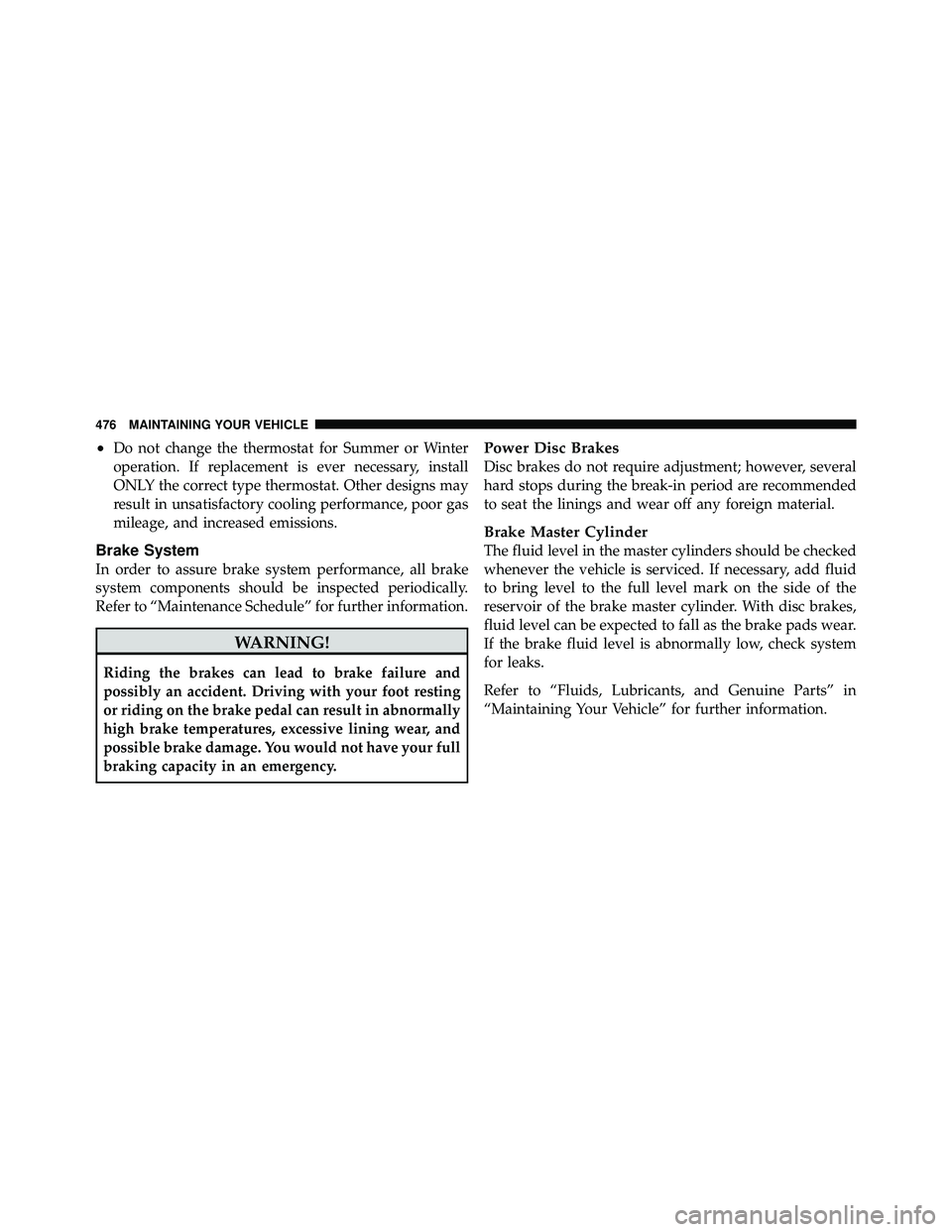
•Do not change the thermostat for Summer or Winter
operation. If replacement is ever necessary, install
ONLY the correct type thermostat. Other designs may
result in unsatisfactory cooling performance, poor gas
mileage, and increased emissions.
Brake System
In order to assure brake system performance, all brake
system components should be inspected periodically.
Refer to “Maintenance Schedule” for further information.
Page 539 of 554
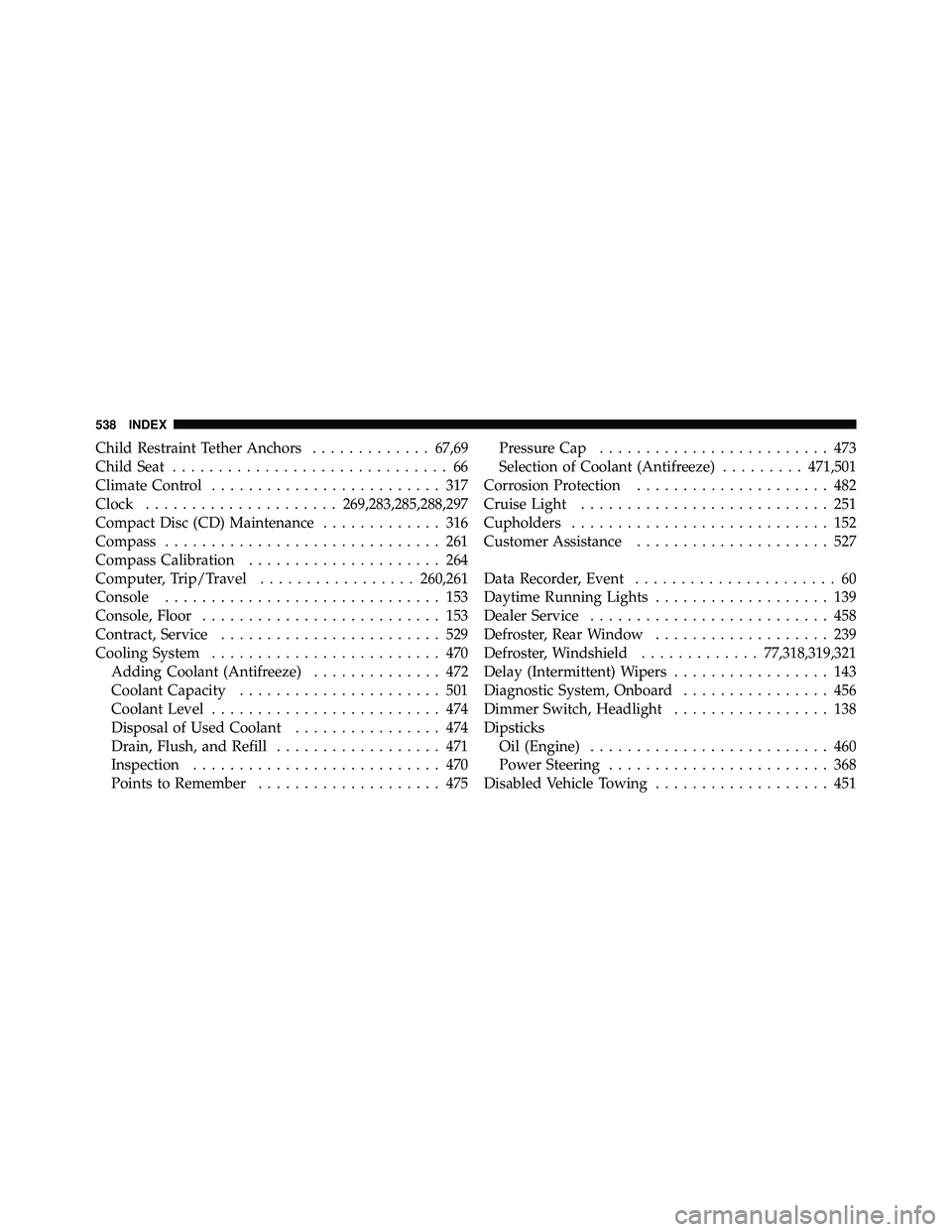
Child Restraint Tether Anchors.............67,69
Child Seat .............................. 66
Climate Control ......................... 317
Clock ..................... 269,283,285,288,297
Compact Disc (CD) Maintenance ............. 316
Compass .............................. 261
Compass Calibration ..................... 264
Computer, Trip/Travel .................260,261
Console .............................. 153
Console, Floor .......................... 153
Contract, Service ........................ 529
Cooling System ......................... 470
Adding Coolant (Antifreeze) .............. 472
Coolant Capacity ...................... 501
Coolant Level ......................... 474
Disposal of Used Coolant ................ 474
Drain, Flush, and Refill .................. 471
Inspection ........................... 470
Points to Remember .................... 475 Pressure Cap
......................... 473
Selection of Coolant (Antifreeze) .........471,501
Corrosion Protection ..................... 482
Cruise Light ........................... 251
Cupholders ............................ 152
Customer Assistance ..................... 527
Data Recorder, Event ...................... 60
Daytime Running Lights ................... 139
Dealer Service .......................... 458
Defroster, Rear Window ................... 239
Defroster, Windshield .............77,318,319,321
Delay (Intermittent) Wipers ................. 143
Diagnostic System, Onboard ................ 456
Dimmer Switch, Headlight ................. 138
Dipsticks Oil (Engine) .......................... 460
Power Steering ........................ 368
Disabled Vehicle Towing ................... 451
538 INDEX
Page 551 of 554

Pressure Monitor System (TPMS)........... 406
Pressure Warning Light .................. 252
Quality Grading ....................... 533
Radial .............................. 401
Replacement ......................... 403
Rotation ............................ 404
Safety .............................. 387
Sizes ............................... 389
Spare Tire ........................... 443
Spinning ............................ 401
Tread Wear Indicators ................... 402
To Open Hood .......................... 135
Tongue Weight/Trailer Weight .............. 427
Torque Converter Clutch .................. 345
Tow Hooks, Emergency ................... 450
Towing ............................ 420,451
24-Hour Towing Assistance ............... 103
Disabled Vehicle ....................... 451
Guide .............................. 424 Recreational
.......................... 435
Weight .............................. 424
Towing Assistance ....................... 103
Trac-Lok Rear Axle ...................... 349
Traction Control ......................... 374
Trailer Sway Control (TSC) ................. 386
Trailer Towing .......................... 420
Cooling System Tips .................... 434
Hitches .......................... 41 1,424
Minimum Requirements ................. 428
Trailer and Tongue Weight ............... 427
Wiring .............................. 432
Trailer Towing Guide ..................... 424
Trailer Weight .......................... 424
Transfer Case ........................... 481
Four-Wheel-Drive Operation .............. 345
Maintenance ......................... 481
Transmission Automatic ........................... 341
550 INDEX